#raid10
Explore tagged Tumblr posts
Text
If you've ever wondered how to afford building your own library 🏴☠️ eBay is great not just for sata drives, but also you can for 15$ buy a SAS controller card and buy discounted enterprise SAS drives for like dirt cheap, they will have a higher failure rate than new drives, but if you use RAID1 or RAID10 you won't lose anything if they die
0 notes
Text
nas: New Synology tips, use SHR2/RAID6 and move shared folders in Control Panel
OK, I thought that I was nearly done. I had reorganized my machines so that I would have RAID10 partitions for half of each 12-bay Synology RP-2423+ and DS-2413+. But then I started reading and discovered that the new Seagate EXOS drives I’ve been buying at 1^15 unrecoverable bit error (UBE) drives even though they are SATA. There was a change over the last five years and the big drives are not…

View On WordPress
0 notes
Photo

🚀 Vuoi elevare il tuo sistema di archiviazione al livello successivo? 😮 Confuso tra le configurazioni RAID 0, 1, 5, 6, 10 e JBOD? 🤔 Noi di G Tech Group abbiamo preparato una guida dettagliata che spiega le differenze tra queste configurazioni! 📘 ✅ Scopri la velocità di RAID 0 ✅ Esplora la sicurezza di RAID 1 ✅ Trova l'equilibrio con RAID 5 e 6 ✅ Massimizza la capacità con JBOD Dai un'occhiata al nostro articolo e fai la scelta giusta per il tuo business! 💼👩💼👨💼 👉 https://gtechgroup.it/raid-0-1-5-6-10-jbod-spieghiamo-le-differenze-tra-le-configurazioni/ 🎯 #RAID #ConfigurazioniRAID #RAID0 #RAID1 #RAID5 #RAID6 #RAID10 #JBOD #Sicurezza #Prestazioni #Velocità #Capacità #Archiviazione #GuidaRAID #Tecnologia #Business #IT #GTechGroup #HelpMePost #SoluzioniIT #Sistema #Hardware Questo post è stato pubblicato con #HelpMePost, provalo anche tu su helpmepost.com! 🚀
0 notes
Text
What is RAID and what are the different RAID modes?
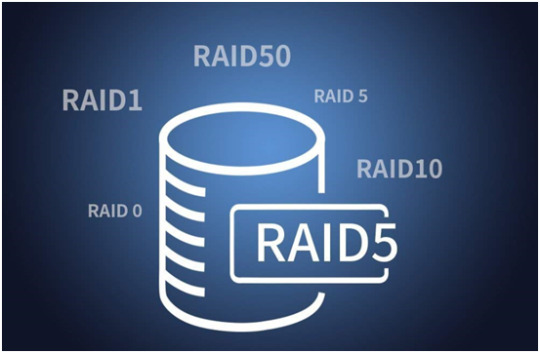
About RAID
RAID is an acronym for Redundant Array of Independent Disks.
RAID is a data storage virtualization technology that combines multiple physical disk drive components into one or more logical units for the purposes of data redundancy, performance improvement, or both.
Data is distributed across the drives in one of several ways, referred to as RAID levels, depending on the required level of redundancy and performance. The different schemes, or data distribution layouts, are named by the word "RAID" followed by a number, for example RAID 0 or RAID 1. Each scheme, or RAID level, provides a different balance among the key goals: reliability, availability, performance, and capacity. RAID levels greater than RAID 0 provide protection against unrecoverable sector read errors, as well as against failures of whole physical drives.
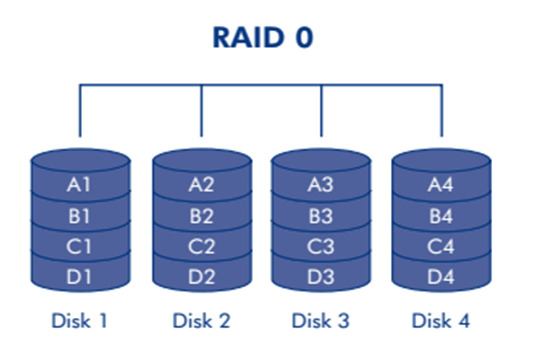
RAID 0 - The fastest transmission speed
RAID 0 consists of striping, but no mirroring or parity.
The capacity of a RAID 0 volume is the same; it is the sum of the capacities of the drives in the set. But because striping distributes the contents of each file among all drives in the set, the failure of any drive causes the entire RAID 0 volume and all files to be lost.
The benefit of RAID 0 is that the throughput of read and write operations to any file is multiplied by the number of drives because, reads and writes are done concurrently.
The cost is increased vulnerability to drive failures—since any drive in a RAID 0 setup failing causes the entire volume to be lost, the average failure rate of the volume rises with the number of attached drives.
RAID 0 does not provide data redundancy but does provide the best performance of any RAID levels.
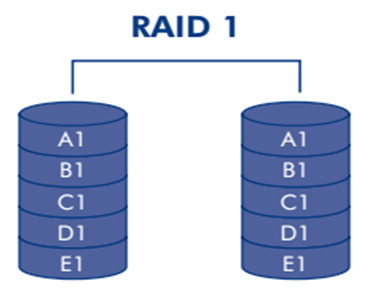
RAID 1 - Data protection is the safest
RAID1 is data protection mode (Mirrored Mode). Half of the capacity is used to store your data and half is used for a duplicate copy. RAID 1 consists of data mirroring, without parity or striping. Data is written identically to two or more drives,If one drive goes down your data is protected because it's duplicated. The array continues to operate as long as at least one drive is functioning.
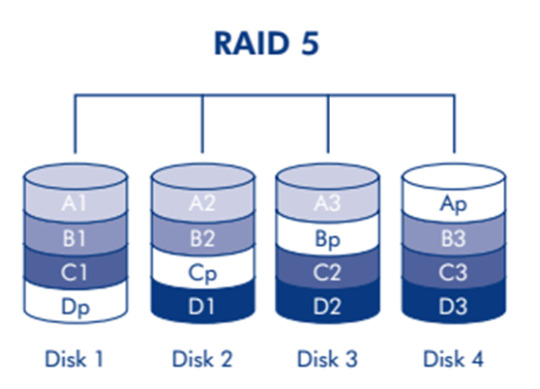
RAID 5 - Best fit Data protection and transmission
RAID 5 consists of block-level striping with distributed parity.
RAID 5 requires at least three disks. In systems with four drives we recommend that you set the system to RAID 5. This gives you the best of both worlds: fast performance by striping data across all drives; data protection by dedicating a quarter of each drive in a four drive system to fault tolerance leaving three quarters of the system capacity available for data storage.
Upon failure of a single drive, subsequent reads can be calculated from the distributed parity such that no data is lost.
The risk is that rebuilding an array requires reading all data from all disks, opening a chance for a second drive failure and the loss of the entire array.

RAID 6 - Large-capacity secure storage RAID6 is more suitable
RAID 6 consists of block-level striping with double distributed parity. Double parity provides fault tolerance up to two failed drives.
RAID 6 requires a minimum of four disks. As with RAID 5, a single drive failure results in reduced performance of the entire array until the failed drive has been replaced.
With a RAID 6 array, using drives from multiple sources and manufacturers, it is possible to mitigate most of the problems associated with RAID 5. The larger the drive capacities and the larger the array size, the more important it becomes to choose RAID 6 instead of RAID 5.
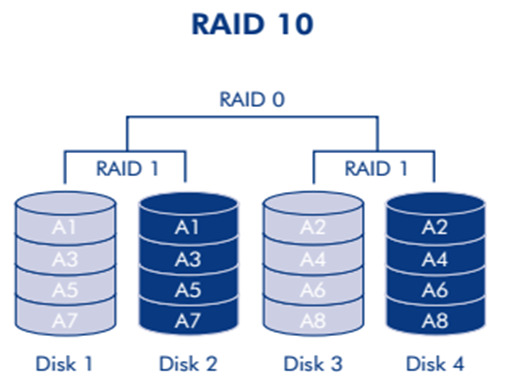
RAID 10 - High reliability and performance
RAID 10, also called RAID 1+0 . RAID 10 is a stripe of mirrors.
Arrays of more than four disks are also possible. A system set to RAID 10 yields half the total capacity of all the drives in the array.
RAID 10 provides better throughput and latency than all other RAID levels except RAID 0. This RAID mode is good for business critical database management solutions that require maximum performance and high fault tolerance. Thus, it is the preferable RAID level for I/O-intensive applications such as database, email, and web servers, as well as for any other use requiring high disk performance.
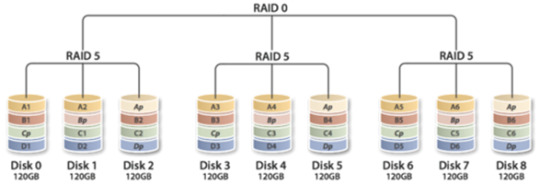
RAID 50 - High reliability and performance
RAID 50, also called RAID 5+0, combines the straight block-level striping of RAID 0 with the distributed parity of RAID 5. As a RAID 0 array striped across RAID 5 elements, minimal RAID 50 configuration requires six drives.
One drive from each of the RAID 5 sets could fail without loss of data; for example, a RAID 50 configuration including three RAID 5 sets can tolerate three maximum potential simultaneous drive failures (but only one per RAID 5 set).
RAID 50 improves upon the performance of RAID 5 particularly during writes, and provides better fault tolerance than a single RAID level does. This level is recommended for applications that require high fault tolerance, capacity and random access performance.
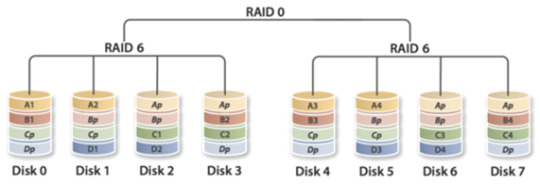
RAID 60 - High reliability and performance
RAID 60, also called RAID 6+0, combines the straight block-level striping of RAID 0 with the distributed double parity of RAID 6, resulting in a RAID 0 array striped across RAID 6 elements. It requires at least eight disks.
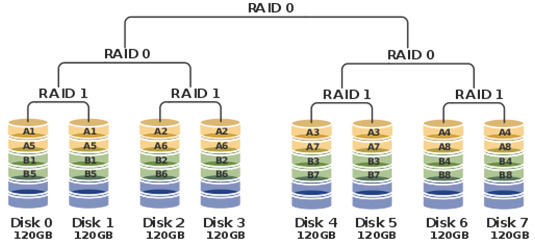
RAID 100 - High reliability and performance
RAID 100, sometimes also called RAID 10+0, is a stripe of RAID 10s. This is logically equivalent to a wider RAID 10 array, but is generally implemented using software RAID 0 over hardware RAID 10. Being "striped two ways", RAID 100 is described as a "plaid RAID".
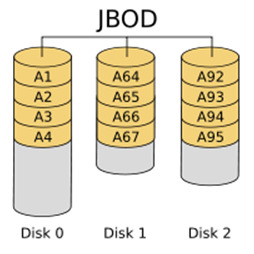
JBOD (Just a Bunch Of Disks)
JBOD (abbreviated from "Just a Bunch Of Disks",also is known as "None RAID") is an architecture using multiple hard drives exposed as individual devices. Hard drives may be treated independently or may be combined into one or more logical volumes using a volume manager like LVM or mdadm, or a device-spanning filesystem like btrfs; such volumes are usually called SPAN or BIG.
A spanned volume provides no redundancy, so failure of a single hard drive amounts to failure of the whole logical volume.
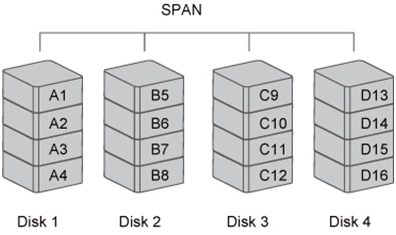
Concatenation (SPAN, BIG, LARGE)
Concatenation or spanning of drives is not one of the numbered RAID levels, but it is a popular method for combining multiple physical disk drives into a single logical disk. It provides no data redundancy.
Spanning provides another maximum capacity solution, which some call it as "Big/Large". Spanning combines multiple hard drives into a single logical unit. Unlike Striping, Spanning writes data to the first physical drive until it reaches full capacity. When the first disk reaches full capacity, data is written to the second physical disk. Spanning provides the maximum possible storage capacity, but does not increase performance.
What makes a SPAN or BIG different from RAID configurations is the possibility for the selection of drives. While RAID usually requires all drives to be of similar capacity and it is preferred that the same or similar drive models are used for performance reasons, a spanned volume does not have such requirements. The advantage of using this mode is that you can add more drives without having to reformat the system.
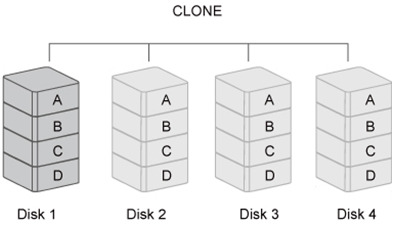
Clone
CLONE consists of at least two drives storing duplicate copies of the same data. In this mode, the data is simultaneously written to two or more disks. Thus, the storage capacity of the disk array is limited to the size of the smallest disk.
RAID Level Comparison
https://www.terra-master.com/global/products.html

#raid#raid1#raid0#raid5#raid6#raid10#raid50#jbod#span#clone#terramaster#raid storage#nas#network storage
3 notes
·
View notes
Text
SQL Server Configuration Recommendations
SQL Server Configuration Recommendations
SQL Server Recommendations The following is the list of general recommendations that are made for your installation of SQL Server. Each instance of SQL Server is unique, so you may have specific configuration requirements that are outside of these recommendations. You will often hear “it depends…” when discussing specific recommendations. People often ask about general recommendations, which is…

View On WordPress
1 note
·
View note
Photo

Finita la comedia. #SAS #диск из дискового массива #RAID10 - видимо, диск пилился очень долго - до того, что оборвало головки. Поскольку это RAID10, то есть и вторая пара дисков (в составе массива #RAID0 конечно). Но там все тоже грустно: второй диск (и, по несч��стью, такой же участник массива, как запиленный накопитель) выпал из состава массива 3 года назад. Массив работал на одной паре дисков не смотря на то, что их было две. Увы, полное восстановление информации с такого массива невозможно: можно извлечь только те данные, которые находятся на первом диске и помещаются в размер одного блока. Даже отказоустойивые массивы не отказоустойчивы, если за ними не следить. #stanislavkorb #datarecoverykg #datarecovery #bishkek #kyrgyzstan #itdoctorkg #бишкек #кыргызстан #восстановлениеинформации #восстановлениеданных #восстановлениеданныхкыргызстан #восстановлениеинформациибишкек #восстановлениедисковогомассива #сервисцентрбишкек #ремонтсервера (at Helsinki) https://www.instagram.com/p/B2uIZmqg5rK/?igshid=1xy0mfffrv0by
#sas#диск#raid10#raid0#stanislavkorb#datarecoverykg#datarecovery#bishkek#kyrgyzstan#itdoctorkg#бишкек#кыргызстан#восстановлениеинформации#восстановлениеданных#восстановлениеданныхкыргызстан#восстановлениеинформациибишкек#восстановлениедисковогомассива#сервисцентрбишкек#ремонтсервера
0 notes
Text
Manual y comandos RAID

Manual y comandos RAID. RAID (Redundant Array of Independent Disks). Cuya traducción sería, Matriz redundante de discos independientes, es una forma de combinar varios discos duros, y poder crear una única unidad lógica en la que se almacenaran los datos de manera redundante. Destaca por ofrecer una mayor tolerancia a fallos, y un gran rendimiento, si lo comparamos con un sólo disco, o un grupo de discos duros. Los datos que se envían a un sistema RAID, se desglosan en fragmentos que a su vez se escriben en los discos de forma paralela. Al hacer uso de este método, la información se reparte entre varios discos, usando técnicas tan dispares como el entrelazado de bloques (RAID 0), o la duplicación de discos (RAID 1) para conseguir redundancia, disminuir el tiempo de acceso, lograr un ancho de banda I/O mayor, y recuperar el sistema tras la avería de alguno de sus discos. Si se produce un fallo en un disco, la tecnología RAID mantiene el servidor trabajando hasta que sustituyas la unidad defectuosa, en ese momento el RAID volverá a operar como tal. Podemos aplicar la tecnología RAID a través de software o hardware, y los tipos más utilizados junto a sus características son los siguientes: RAID 0 Se requiere un mínimo de 2 discos duros. Puede soportar un máximo de 32 discos duros. Los datos se escriben de manera simultánea y uniforme en los múltiples discos duros. La velocidad de lectura y escritura es muy rápida. No dispone de tolerancia a fallos. RAID 1 Utiliza solo 2 discos duros. Los mismos datos se escriben simultáneamente en los discos (espejo). La velocidad de lectura es rápida, y la velocidad de escritura no tanto. Tiene tolerancia a fallos. Por su funcionalidad y uso es el más utilizado en servidores web dedicados. RAID 5 Se requiere un mínimo de 3 discos duros. Puede soportar un máximo de 32 discos duros. Los datos se escriben de manera simultánea y uniforme en varios discos duros. La paridad se escribe por igual en todos los discos. La velocidad de lectura y escritura es rápida. Tiene tolerancia a fallos. Recomendado para servidores de alta disponibilidad. RAID 10 Se requiere un mínimo de 4 discos duros. Puede soportar un máximo de 32 discos duros, pero siempre agregados por pares. Sistema híbrido entre RAID 0 y RAID 1. Tiene tolerancia a fallos. La velocidad de lectura y escritura es rápida. Es el más utilizado en VPS.
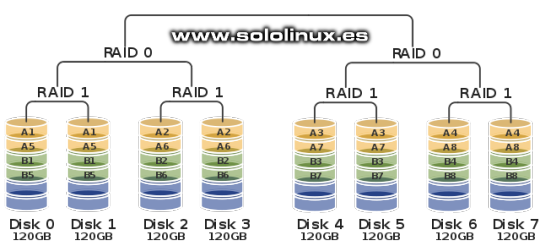
RAID 0+1
Manual y comandos RAID
Agrupar particiones en una matriz RAID. mdadm –C /dev/md0 -n -l Formatear el dispositivo RAID. mkfs.ext3 /dev/md0 Crear un punto de montaje. mkdir Montar la partición RAID. mount /dev/md0 Marcar dispositivo como defectuoso. mdadm -f /dev/md0 Quitar una partición de la matriz RAID. mdadm -r /dev/md0 Agregar una nueva partición a la matriz RAID. mdadm -a /dev/md0 Mostrar el dispositivo RAID. mdadm -d /dev/md0 Detener el RAID (antes de detener, debes desmontar). mdadm -s /dev/md0 Ensamblar el RAID. mdadm -a /dev/md0 Con este articulo ya tenemos nuestro primer contacto con el sistema RAID, continuaremos. Espero que este articulo te sea de utilidad, puedes ayudarnos a mantener el servidor con una donación (paypal), o también colaborar con el simple gesto de compartir nuestros artículos en tu sitio web, blog, foro o redes sociales. Read the full article
#comandosRAID#discos#discosduros#hardware#manual#raid#RAID0#raid1#RAID10#RAID5#RedundantArrayofIndependentDisks#tecnologíaRAID#vps
0 notes
Text
ピュアSSD RAID10構成のハイスペックサーバーがビジネスにもたらす5つのメリット
高速で安定したピュアSSD RAID10構成のハイスペックサーバーの利点につ���て説明します。ビジネスにとって、高速かつ信頼性の高いサーバーは重要です。ビジネスがオンラインで成長するにつれて、高速で安定したサーバーの重要性が増しています。ピュアSSD RAID10構成のハイスペックサーバーを利用することで、ビジネスは高速かつ安定したサービスを提供できます。以下では、このタイプのサーバーの主なメリットについて詳しく説明します。1.高速な読み取りと書き込みピュアSSD RAID10構成のハイスペックサーバーは、高速な読み取りと書き込みが可能です。SSDが持つ高速な書き込み速度や読み取り速度が理由です。ビジネスにとって、データのアクセス速度が速いことは非常に重要です。高速な読み取りと書き込みが可能なピュアSSD…

View On WordPress
0 notes
Photo

New Post has been published on http://www.thessdreview.com/raid-enterprise/raid-cards/highpoint-ssd7101a-1-nvme-raid-controller-review-samsung-toshiba-m-2-ssds-tested/
HighPoint SSD7101A-1 NVMe RAID Controller Review - Samsung and Toshiba M.2 SSDs Tested
When it comes to storage management RAID configurations of some kind have proven to be top dog when it comes to performance. This was initial shown in our report of the Intel 910 PCIe SSD way back in 2010 and, more recently, with the Kingston DCP1000 NVMe SSD that reached 7GB/s throughput...
#960 PRO#Anvil#AS SSD#ATTO#Crystal DiskMark#HighPoint#Iometer#M.2#NVMe#pcie 3.0#raid controller#RAID0#RAID1#RAID10#RAID5#RD400#Samsung#SSD#SSD7101#SSD7101A-1#Toshiba#X16
0 notes
Text
エックスサーバーが新規受付サーバーへのオールSSD RAID10構成採用
何と!エックスサーバーが今後新規に受け付けるサーバーに対して、オールSSD RAID10を採用するとのアナウンスがありました。
これにより、従来のHDD環境と比較してディスクの読み込み速度が【48倍以上】に向上しており、データの読み書きによるボトルネックが大幅に改善された、非常に高速かつ安定したサーバー環境が利用可能です。
SSDは、Solid State Driveの略で、フラッシュメモリを用いて電気的にデータを読み書きするストレージデバイスで、物理的にデータを読み書きするHDDより、ディスク読み込み速度や耐故障性能などが大幅に向上しています。
RAID10とは… の前に
RAID0とは、複数台のディスクを使用することで、データの読み書きを効率化し、処理速度を向上させる仕組み(ストライピング)です。 RAID1とは、同じデータを���数台のディスクに書き込みすることで、耐障害性を高める仕組み…
View On WordPress
0 notes
Text
RouterHosting: VPS Linux/Windows 4GB RAM, 80GB SSD chỉ $9.95/m
RouterHosting thành lập năm 2018 có trụ sở tại Los Angeles California Hoa Kỳ. Họ cung cấp VPS Linux và Windows với giá rẻ. Hiện họ đang bán các gói VPS Linux và Windows với giá rẻ mà cấu hình tương đối tốt: Linux VPS Windows VPS Locations: Los Angeles – USA Roubaix –...
Xem toàn bộ bài viết: RouterHosting: VPS Linux/Windows 4GB RAM, 80GB SSD chỉ $9.95/m
0 notes
Link
HDDをミラーリング(二重化)してデータを守るRAIDシステムの活用についての一覧です。
・データ紛失 必要なデータの紛失に遭った後に後で復元する対処法について。 ・Windows 8 システムの復元 Windows 8のOSでシステムの復元を行う時の注意点について。 ・Windows ファイル履歴 Windows8のファイル履歴の機能で消えたデータを復元する手順について。 ・Windows7のファイルの回復 Windows8に搭載されたWindows7のファイルの回復機能について。br> ・添付ファイル 開けない 電子メールに添付したファイルが開けない時の対処方法について。 ・筆ぐるめ 住所録 消えた 筆ぐるめのソフトウェアで住所録データが消えた時の直し方について。 ・HDDビデオカメラ データ復旧 HDDビデオカメラから映像や写真のデータを削除した時に復旧させる方法について。 ・壊れたファイルを修復 拡張子のプログラムが破損して壊れたファイルを回復する方法について。 ・外付けHDD 起動しない 外付けHDDの電源を入れてパソコンに読み込ませようとしたら起動できずデータが開けない、という時の主な原因について。 ・USBメモリ データ 消えた USBメモリに保存してあったファイルがいつの間にか消えてしまった、というトラブルが発生した時の原因について。 ・ハードディスク カチカチ音 パソコン等に内蔵されたハードディスクドライブから「カタカタ…」「カチカチ…」と異音が鳴り出した場合について。 ・RAID6 故障 RAID 6(レイド6)でディスクアレイに搭載したHDDの保存データを保護・復旧する手法について。 ・ネットワークドライブ 削除 復元 NAS等のネットワークドライブに保存していたファイルを誤って削除してしまった時の復元方法について。 ・HDD 取り外し ハードディスクドライブをパソコン等のコンピューターから取り外して新品に入れ替えする時の交換作業の手順について。 ・切り取り データ 復元 パソコン作業中にファイルやフォルダの切り取りに失敗してデータが消えた場合の復元の仕方について。 ・ノートパソコン HDD データ 取り出し ノート型パソコンのパーツが故障して開けなくなった時に内部のデータを取り出しする手順について。 ・外付けハードディスク 寿命 外付けハードディスクドライブの製品としての寿命はどれくらい?という疑問について。 ・デスクトップ データ 消えた デスクトップ画面上からショートカットアイコンやフォルダが消えた時の復旧手段について。 ・DVD-RW データ PC 見れない 復元 DVD-RWに書き込みしたデータが閲覧できない、という時に考えられる障害の原因の一覧です。 ・電源が止まってデータを喪失 パソコンの電源が停電などで止まってデータが消えてしまうトラブルを防ぐ対策について。
0 notes
Photo

Finally, I'll be able to #backup my #file #server #RAID10 array and repurpose it as a #VM server like it should be. (at Lake Manawa)
0 notes
Text
What is SSD VPS?
SSD VPS facilitating is a propelled rendition of conventional VPS facilitating. One of the greatest contrast between ordinary VPS and SSD controlled VPS facilitating is the type the of extra room utilized by servers. In SSD VPS servers/facilitating condition, SSD's are utilized as the default mode of capacity which works completely much superior to HDDs (Hard Disk Drive) utilized in VPS. The following is the screen capture of SSD VPS facilitating plans of ARZHost:

Different points of interest in SSD VPS facilitating.
SSDs, are the present-day type of capacity gadgets dependent on completely streak based memory. These SSD's supplant circle based HDD based capacity in speed, security, unwavering quality, and numerous different variables. At ARZHost we utilize 100% unadulterated SSD stockpiling for our each virtual private server with RAID10 stockpiling reflecting innovation to secure your information. Referenced underneath are the advantages of SSD VPS Hosting:
Because of the execution of SSDs as capacity media, SSD VPS server accompanies a lot quicker server reaction time which results to bring down dormancy than customary VPS facilitating.
SSD servers are a lot quicker contrast with HDDs in light of the fact that information has not to be perused by moving structure which is another preferred standpoint of SSD VPS
SSD VPS offers a lot quicker information exchange and data transfer capacity since it contains the quick speed of perusing/composing
With rapid of perusing/composing skills of Solid-state stockpiling
Because of it's to lightweight highlight, basic strength and against vibration structure, SSDs are considerably less inclined to physical disappointments. This makes SSD based servers are very solid in contrast with HDDs.
SSD (Solid State Disk) is the shortened form of Solid State Drive. SSD drives are worked by gathering the coordinated circuits which store the information proficiently on the servers. In contrast to the HDD (Hard Disk Drive), SSDs have no programmed arm controlling and appreciating information from the attractive circle. SSDs are quicker contrasted with the hard plate drive and thus, it is been supplanted. SSDs drives additionally accompany string structures and are impervious to vibrations and are shockproof as well, making them all the more dominant contrasted with the customary HDDs.
SSD VPS facilitating is the most recent sort of facilitating administrations. The primary distinction between the typical VPS and SSD based VPS facilitating is the extra room used by the servers. In the SSD based VPS server, the drives come as the default stockpiling medium and they perform very much contrasted with the HDDs. SSD is the glimmer based memory and it has supplanted the HDD stockpiling identified with the security, dependability, and speed among various components. In the event that you are looking for the SSD VPS facilitating supplier, at that point you can settle on ARZHost SSD VPS facilitating. In ARZHost they offer SSD stockpiling for all VPS facilitating plan with RAID 10 stockpiling innovation for verifying the information.
ARZHost SSD VPS:
ARZHost gives SSD stockpiling to all VPS server plans. What's more, ARZHost VPS Plans accompanies RAID 10 stockpiling innovation for the most elevated assurance of the client's information. Also, besides, top of the line hardware is utilized with their VPS facilitating plans. ARZHost SSD VPS Servers are of best performing and endeavors grade VPS server. And furthermore, ARZHost SSD VPS Plans joins creative and present-day advances.
ARZHost SSD VPS Hosting will be the correct decision for your site as it accompanies the most moderate costs. In ARZHost they additionally give oversaw SSD VPS facilitating. The individuals who are in the requirement for the advantages of an oversaw VPS at a decent speed of SSD drives at a reasonable value then ARZHost SSD VPS will be the correct stage. Their Managed SSD VPS plans to accompany all the expected highlights to have your site. What's more, they additionally oversee administrations like Httpd, MySQL, Exim, and significantly more. ARZHost SSD VPS administrations are totally dealt with by their group as the customers need to just transfer the documents and rest all will be overseen by their colleague.
SSD VPS is these days more popular. As there is a wide range of projects and functionalities that may require some additional RAM and CPU, there is a need for VPS. Presently, VPS can assist you with getting the intensity of the committed server at a lesser expense without trading off the highlights of the devoted server. In some cases, an application or program requires additional designs of factors that are not accessible in mutual facilitating. In such a situation, we would a VPS comes into the picture. VPS enables you to adjust or stack additional module or expansion or patches identified with apache or ningx or any windows programs. Such administrator or root highlights can assist you with getting the additional power at your simplicity to deal with the VPS.
Here is a guide of migrating WordPress to VPS
youtube
Buy VPS SSD
VPS comes in a wide range of flavors beginning from Buy VPS SSD, VPS NVMe, VPS Cloud and other cloud VPS for better equipment controls. VPS is something Virtual where CPU centers and RAM for all intents and purposes imparted to the majority of the clients identified with the VPS stage. By one way or another, if your necessity gets surpassed regarding transfer speed or traffic, you can go for a higher arrangement. In spite of the fact that a little arrangement begins from $6.99 every month for a VPS, yet a higher arrangement goes past $100 every month. On the off chance that case on the off chance that you need high accessibility and requires committed CPU, RAM, and HDD, you can consider open cloud or devoted server at moderate valuing which begins from $30 for a devoted server too. Get a SSD VPS as low as $6.75.

SSD and VPS are two distinct terms. SSD signifies "Strong State Drive" and VPS means "Virtual Private Server"
Let's comprehend SSD first in short:
SSD is a capacity gadget (like our telephone memory card) containing non-unstable glimmer memory, utilized instead of a hard plate due to its a lot more noteworthy speed.
Virtual Private Server VPS:
VPS is a virtual piece of a devoted server. SSD is utilized in VPS for the capacity of sites including sight and sound documents. SSD VPS are commonly known crashable by and large and are a lot quicker than HDD (Hard Disk Drive) VPS.
SSD VPS is dependable in execution insightful.
A VPS has its very own duplicate of the working framework and dispensed server assets, inside a greater/Dedicated server.
For more data, you can google it. Each individual has depicted SSD VPS in their own specific manner.
Here is the complete guide of What is Dedicated Server and How to buy.
Read about best web hosting companies.
11 notes
·
View notes
Text
请问有老板家可以提供多c段的香港母鸡吗
手里有个站群项目。 Ip如果能8个C或者更多C 且跨度大点 那就太好了。前期可能100个ip左右就够了。 硬盘需要 总大小8T SSD 因为要做raid10 上行带宽30M 最好是cn2 内存256G 如果能是ddr4 那就更好了 Cpu 2×E5 。 价格能在4000一个月内吗??年付能在4万内吗??
<a href=‘https://whatismyip.com’>大佬这个项目有点大啊</a>。?
一堆垃圾站 扔着做站群而已。。。垃圾项目。
不要IP的话半年付2万 没问题
HK那边这么贵的么
卧槽 你要求这配置。。这价格还贵啊。。
怕别人带着机器跑路。。。也不知道怎么把机器邮寄过去
1 note
·
View note
Text
Time for some hardware changes --- part 0
... continuing a story, that began on Facebook. But I mentioned in my last post, I dump Facebook. So we need a transistion of the information to tumblr...
What happens before?
{TL;DR} I'm angry about my energy costs. I have 5200 kWh / year, which is here in Germany the amount of a 5 person household. I'm single, but IT-nerd. {end TL;DR} So I have some infrastructure in company design and size: Two internet connections (1 DSL 100Mb, 1 LTE 40MB) connected via 8 port 1000-base T switch to a gateway server (DMZ) with firewall and vpn to connect over internet, another vpn to my big servers in the data center, and some other services. This server is connected via a second network interface to a 50-port 1000-base T switch (internal zone), there attached a fileserver with NVMe SSD boot and storage RAID10 with 4 Terascale datacenter drives. Also attached two NAS (but 99% switched off) for a third backup level. Also attached a WiFi Accesspoint with (net) 800 Mb, bridging to two other WiFi Accesspoints in my appartment (for my ESP-32 devices WLAN). Also attached two other switches: One of them is an 8 port 1000-base T for my "free time PC" (so I don't need the big PC for fun after work), an IP phone and an ("oversize") ink printer with scanner. That was the first decision for energy saving. The additional PC saves a lot of energy costs instead of the big one. It is consuming with all its environment (two screens, external speakers, graphic tablet, pen tablet screen) 75% of the the big PC alone (see below). Second decision: All these devices are connected to a real power switch via radio, so everything is really switched off, if not in use. So no consuming energy in standby mode. The other switch is a 16 port 1000-base T in my home office. The 16 port switch has connected my dev PC (2 Xeon CPUs, 96GB RAM, SSD, 6TB net via LSI SAS hardware RAID10 and a lot of USB 3 ports), the dev PC has 1 x 48" UHD curved & 2 x 40" UHD curved (all with network ports). I can connect another 5 screens... but mostly I work witt only two of the big screens... they are representing the usage of 8 normal HD screens... ). Ok. There is another smaller PC connected to the switch for administrative work (2 Xeion CPUs, 24GB Ram, SSD, some TB HDD. Then two network printers, a b/w HP LaserJet and an HP PageWidth inkjet printer. Then two IP-phones. And an UHD bluray player with network connection. Third decision: All of this - except the network switch and the phones are connected to a radio controlled powerswitch as well. Someone wondering about my energy costs? But with these decisions above, I came from 14,5 kWh/day to 13,4 kWh/day. You are up to date now. Time to make more decisions... in part 1 Read the full article
0 notes